The first KC
accredited agility instructor
 You
could have knocked Lesley Young down with a feather when Sue Evans told her that she would be
the first person to become a Kennel Club Accredited Instructor, under the Agility speciality.
As Lesley put it, 'The feeling was a bit like completing your first gruelling marathon only to
look back over the finishing line and find that everyone else has made a detour to take in the
sights - both satisfying and bemusing.' Soraya Porter interviews her to find out what it's all
about. You
could have knocked Lesley Young down with a feather when Sue Evans told her that she would be
the first person to become a Kennel Club Accredited Instructor, under the Agility speciality.
As Lesley put it, 'The feeling was a bit like completing your first gruelling marathon only to
look back over the finishing line and find that everyone else has made a detour to take in the
sights - both satisfying and bemusing.' Soraya Porter interviews her to find out what it's all
about.
I started out by asking Lesley to tell us a little more about how she got into agility in the
first place.
It all started about
about 15 years ago at a
wedding when I met Carol Whitmore
co-founder of the Agility Section at Aylesbury CTS. Next morning I turned up at 8.00am
in the pouring rain with a wet dog and a hangover. The rest, as they say, is history!
Next I asked her about her own dogs.
My first agility dogs
were both rescued crossbreeds. Barnaby was a lurcher(ish) and Tommy a Staffie/Whippet. We
trained at ACTS, a great multi-discipline club, and got some excellent teaching in-club.
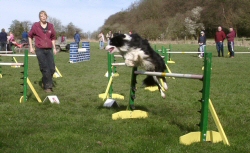 I
now run two red and white Border Collies - Mace (aged 5) and Star (now 9). Both are in Grade
6. My youngster Paddy - also a collie- has been my biggest challenge thus far. He won into
Grade 4 in August. I currently train with Diane Griffin who has been brilliant. Paddy is much
more 'driven' than any dog I've ever had before and I've had to totally adapt my handling style
for him. I've also changed his diet to a lower protein and lower fat food which has also helped
calm him down. I
now run two red and white Border Collies - Mace (aged 5) and Star (now 9). Both are in Grade
6. My youngster Paddy - also a collie- has been my biggest challenge thus far. He won into
Grade 4 in August. I currently train with Diane Griffin who has been brilliant. Paddy is much
more 'driven' than any dog I've ever had before and I've had to totally adapt my handling style
for him. I've also changed his diet to a lower protein and lower fat food which has also helped
calm him down.
Over the last 15 years
I have had some really good teaching input from some excellent people like Steve Seale, Kathrin
Tasker, Sue White and Jon Watts as well as behaviourist and vet - Hannah Lyon. Hopefully, I am
now passing that on in a good way to the wide range of dogs in our club Fun and Reward Ashridge
Canine Agility Society (FRACAS
)
Before we talked about the actual KCAI scheme, I wanted to find out more about Lesley and how
she got into teaching agility.
I started teaching at the same time
as Jill Spurr when ACTS needed some new instructors. That was in 1997. The club sponsored us to
go on the Agility Club Instructors Course in 1999.
In 2003, Colin Harpley and I
launched FRACAS, initially as a 'fun agility' dog club. We were soon joined by Nick Lee
who now competes in Grade 5 with a
Medium dog. We have trained up
other instructors as well including Kate Taunton who recently passed her Agility Club
Instructors Course.
We
now have quite a few people getting out into competition, quietly achieving some great results,
but we still don't position ourselves as a primarily 'competition' club. We have social
events like a Christmas dinner dance, pub lunches and club walks and last year we
raised £1600 for Chilterns Dog
Rescue with our Agilitython.'
In 2006 I moved about five miles from
our FRACAS venue to Flaunden (Herts) and took redundancy from my corporate career to become a
freelance dog trainer. I added Puppy & Companion Dog Training and extra Agility classes to
those we were already offering at the main club. I also set up a little extension to the main
club called Dog Angels which offers services like dog walking, behaviour help and puppy
sitting, mainly to club members. Our links with ACTS remain strong. For example, Colin is the
ACTS Show Manager.
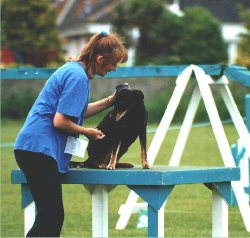 So,
what exactly is a Kennel Club Accredited Instructor? So,
what exactly is a Kennel Club Accredited Instructor?
The KCAI is a national
accreditation scheme for dog training instructors which includes a range of dog training
disciplines such as Competitive Obedience, Working Gundog training and Heel Work to Music as
well as Agility. It was launched in 2001 and is run by approved instructors under the auspices
of The Kennel Club. To quote the KC welcome pack, it aims to unite all who work within the
field of dog training and canine behaviour and to develop the best service possible for the
dog-owning public and training enthusiasts.
Why
do you feel it would be worthwhile for someone in the Agility world?
I've often heard it said that agility
people are just focused on competition and fast collies. Whilst that may be true of some
people, I have found an incredible wealth of broader dog knowledge and understanding in the
Agility world and a wider range of dogs, than that statement would suggest. And let's
face it, collies are not without their problems - quite possibly there are more rescued collies
'with issues' than most other breeds.
Like the vast majority of agility
trainers, to me, Agility is about getting the best out of every dog and for dog and handler to
enjoy the 'journey' to improve their working relationship. That's partly about teaching
the equipment and handling skills but also far more encompassing. Surely, the steady
rehabilitation of a terrified dog, or achieving clear rounds with a previously uncontrolled dog
are as satisfying as winning into the higher grades with a dog from a selected agility
line? This calls for a broader and deeper understanding. It's about enjoying the
journey, not just the destination.
So
why did you personally decide to go for it?
I decided to undertake
the KCAI scheme for several reasons. Leaving the secure structure of 'corporate life'
to be a professional
dog trainer was a scary step, and I thought it would be a good foundation for my own
personal and professional development.
It
is all too easy to become too focused on one aspect of dog training like agility. The KCAI
scheme requires you to take a wider view. To qualify you need to know more about things like
dog care, welfare and safety, understanding canine behaviour and dealing with problems, laws
and legal responsibilities and running a professional service.
The scheme really does help you to identify gaps in your
knowledge and to take action. For example, I was prompted to make contact with other local
'dog' folks like the two local dog wardens, other dog walkers and trainers etc. I was a bit shy
of doing that, but it has really reaped benefits as we have been able to refer each other to
potential clients. Also, although I passed the teaching assessment for the Companion Dog (pet
dog) classes, I need to re-apply in a year when I have more teaching time under my belt in
order to gain the necessary points. The Assessors also recommended specific areas I could
follow up on, which would further ensure the accreditation for Companion Dog specialty sails
through next year.
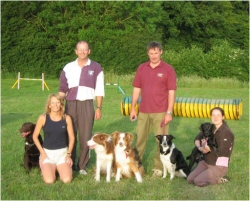 On
a club level, we naturally hope that gaining the initials KCAI will help attract new members,
although to be honest, like most agility clubs we are at capacity for new Agility beginners and
have a small waiting list. We plan to bring on some more instructors so that we can offer some
more beginner classes.
We like
the way it captures knowledge across the range of dog training activities and does not tie you
to any particular style or method of training. We work on the philosophy that every dog is
different and have always tried to tailor training to a particular dog and handler combination. As
a team, we agreed I would take the plunge first! I'm sure they are 'right behind me' though. On
a club level, we naturally hope that gaining the initials KCAI will help attract new members,
although to be honest, like most agility clubs we are at capacity for new Agility beginners and
have a small waiting list. We plan to bring on some more instructors so that we can offer some
more beginner classes.
We like
the way it captures knowledge across the range of dog training activities and does not tie you
to any particular style or method of training. We work on the philosophy that every dog is
different and have always tried to tailor training to a particular dog and handler combination. As
a team, we agreed I would take the plunge first! I'm sure they are 'right behind me' though.
This all sounds great, but what did you actually have to do to get KCAI accreditation?
Like any portfolio based
accreditation, the scheme is not a walkover!
First of
all,
you have to understand that this isn't a course.
It
consists of a two stage assessment which has been developed by a number of very knowledgeable,
well qualified dog trainers, in consultation with all the main dog sports including Agility. It
is very flexible and offers many individual options.
Stage 1 is a self-assessment in which
you collate evidence of your experience and qualifications and compare it to the KCAI criteria
to determine if you are ready. That can take anything from a few months to several years
depending on how much you focus on it and your starting point. You need three years experience
to join the scheme and five years experience as a minimum, to gain the necessary points to
pass.
This stage is
divided into
three sections whose purpose is to
evaluate the depth and breadth of your knowledge, specifically:-
-
Knowledge - Theory
-
Practical experience as a dog
owner or dog handler
-
Teaching experience
Each section is broken into a number of modules (subjects).
Sections A and Section C are both comprised of 10 required modules on such topics as
Understanding Dog Behaviour (A4); Laws and Responsibilities (A8), Planning and Running
Training Sessions (C2) and Managing, Resources and Safety (C8). I found it a really is a good
grounding for running your own classes.
Section B is a bit different. The number of Section B
modules depends upon your own interests and experience, but you need a good few to make up
enough points to pass. It definitely helps to be able to demonstrate a higher level of
involvement such as acting in an official or contributory capacity. In Agility, for example,
this could include acting as a Ring Manager, Judging or being on a Show Committee.
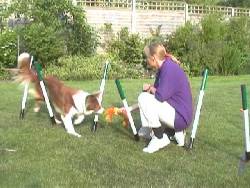 Stage
2 is the official accreditation assessment. In my case, I had Di Morgan, an experienced
assessor and member of the scheme Board as my official Assessor with Chris Bloomfield who is
training as an Assessor having recently gained KCAI for Companion Dog and Obedience,
accompanied by Sue Evans. Stage
2 is the official accreditation assessment. In my case, I had Di Morgan, an experienced
assessor and member of the scheme Board as my official Assessor with Chris Bloomfield who is
training as an Assessor having recently gained KCAI for Companion Dog and Obedience,
accompanied by Sue Evans.
I can remember early one evening back in June, standing
under the carport, peering through torrential rain, down the driveway hoping for a glimpse of
the Assessment team. The heavens had opened and I could barely make out the road. Huge
raindrops were now bouncing off my dog walk.
Thankfully, the arrival of the Assessor party coincided with the passing of the storm. Either
that or they waited in the car till it passed!
They were with me - face-to-face -for 16 hours over two
days, running through my portfolio and watching me teach for three hours. Overall they were
happy with what they saw, but felt that as this would be the first Agility accreditation, they
wanted extra validation from a recognized Agility 'name.' They arranged for Dave Jolly to come
along to assess me over a further evening. It was pretty exhausting, but then they were all
there, too so I can hardly complain!
Naturally, it helped to
have undertaken formal courses as this evidence is pretty clear. After the Agility Club
Seminar, I completed the BIPDT (British Institute of Professional Dog Trainers) in 2003 and the
COAPE (Behavioural) Advanced Diploma this year, but informal discussions such as instructor
meetings also carry weight under different modules. You can also accumulate points for other
experiences such as visits to other clubs.
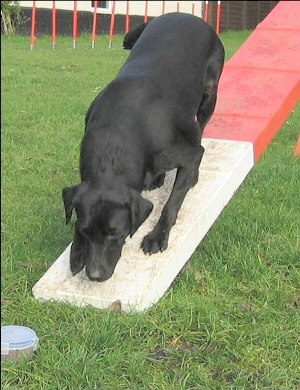 Objectively
can I ask what was your opinion of the scheme? Objectively
can I ask what was your opinion of the scheme?
Looking back on it,
I feel that the points system for Agility needs a bit of a review. For example, the score for
achieving Grade 6 in Agility is much lower than getting a Gold in Good Citizen, whereas
arguably, the challenge involved is significantly
harder!
Personally
I found the current points system a bit
cumbersome. An Excel version would really help you re-calculate every time points
change! Apparently this is on the list of enhancements.
As the modules count
separately, there is some discussion of splitting the agility module into two, specifically:-
- Non-competitive
agility
- Competition
agility
Regardless I think
Agility Instructors need to deal with a whole range of issues, from fear to aggression, handler
stress, club management etc. The scheme recognises and accredits this.
There is a lot of detail involved in the scheme and potentially that could put some people off.
I found it easier to set the time aside to blitz my self-assessment because then I was able to
'get into' how the scheme works. I think if you spread it out over a long period you might have
to re-acquaint yourself with how it works each time you return to it. But that's just me.
It was a long journey towards assessment and it took a lot of work and time to do the scheme
but I thought it was worth it. Ultimately it can only be in the best interest of dogs, dog
owners and instructors who want to really improve their knowledge and offer a good service to
their students. Of course, it's not the only way to become a good dog trainer - as many
acknowledged 'top' Agility Instructors will attest - but it is one way, which I think will
become increasingly valued by dog teaching professionals.
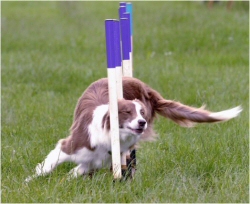 Other
than the amount of time and effort you put into the course work, what does it cost? Other
than the amount of time and effort you put into the course work, what does it cost?
It is not expensive to take the
qualification when you compare it to most of the 'professional' qualifications. The cost is
spit into two elements – enrolment is £45 for hobby Instructors, £60 for business
Instructors. The assessment is £60 and £90 respectively.
What would you say to anyone thinking of going for accreditation?
If you are considering the scheme, my personal advice is to combine formal training with
practical experience. Join a multi-discipline club or get out there and visit other clubs.
Don't be put off by the level of detail the scheme entails, Rather, view it as a personal
development tool, as opposed to a once off certification,
I just want to thank Sue Evans, who organises the scheme,
for being so supportive and encouraging. Her input was so positive! Thanks Sue! I am sure she
would be happy to talk to anyone about taking the scheme.
Thank you, Lesley for agreeing to be interviewed, and huge congratulations on gaining your KCAI.
To find out more
about the KCAI scheme, ring Sue Evans the Scheme Administrator on tel. 020 7518 1039 or email:
sue.evans@thekennelclub.org.uk
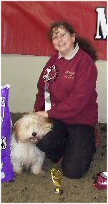 About
the interviewer... About
the interviewer...
Soraya
Porter lives in the smallest town in England - Manningtree, sharing her house with three
Siamese cats and her dog Ernest (Hartsfern In Earnest) who also can be heard answering to the
names of Ernie, Ern, Monster, Beast and Fish Face! Ernie runs at Grade 7, and has had many
appearances at Crufts, where he is in great demand to pose for photographs with Japanese
tourists!
Currently she trains
at Colchester Dog Agility Club and Valley Farm Agility Club, as well as doing some freelance
teaching, the odd judging appointment, designing simple agility websites, and hand spinning dog
fibre. Given such ingrained insanity, it’s a miracle that Ernie has taken part in as many
Finals as he has.
First published 8 January 2008
|